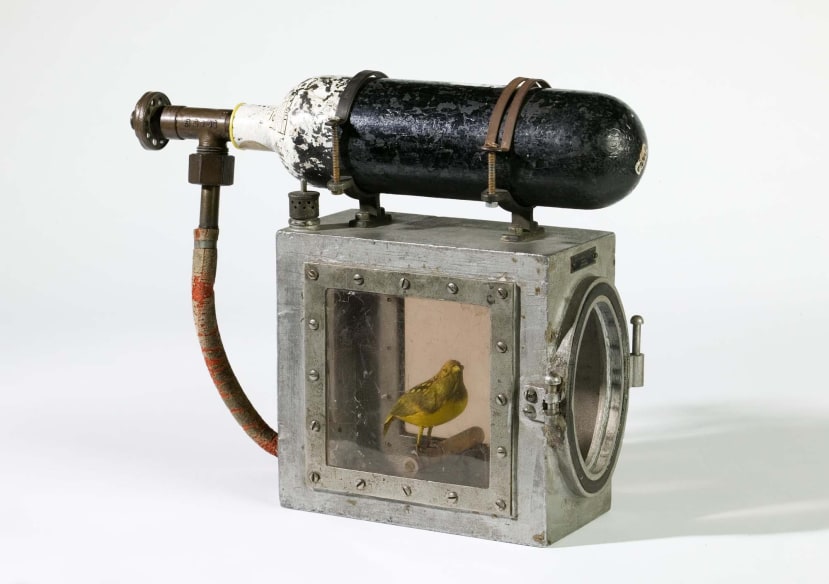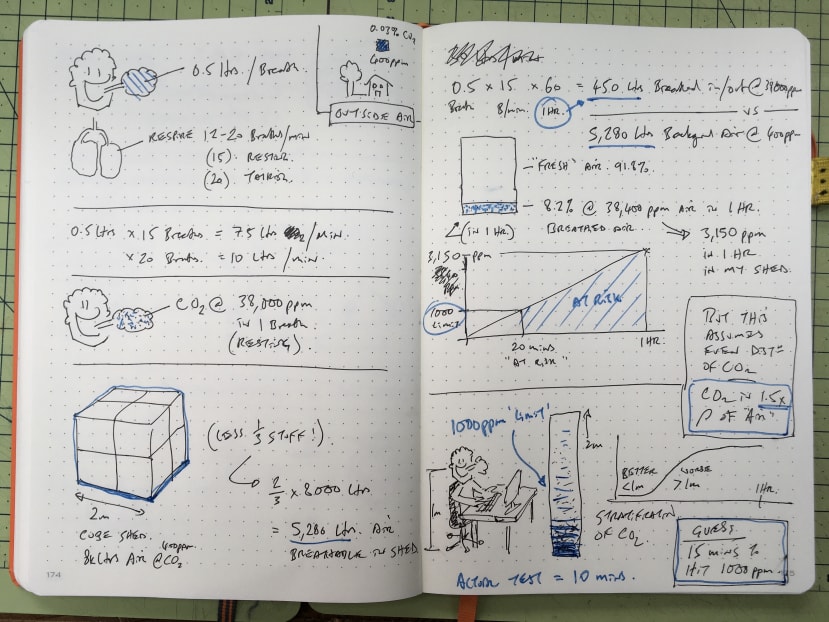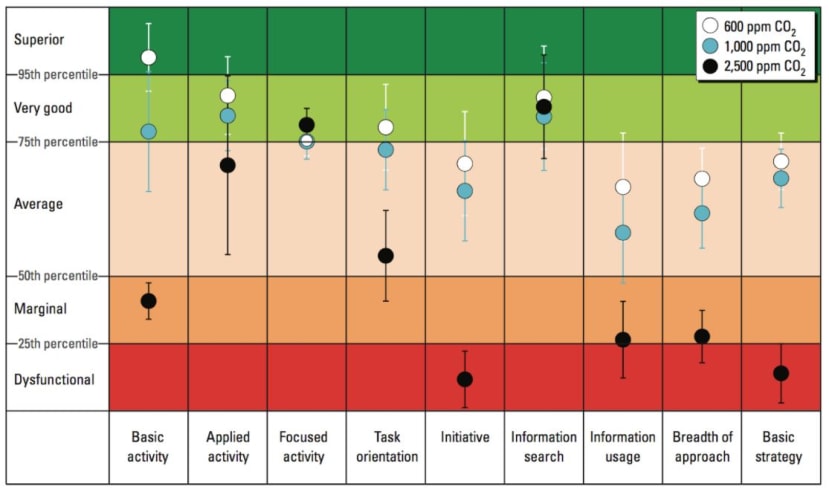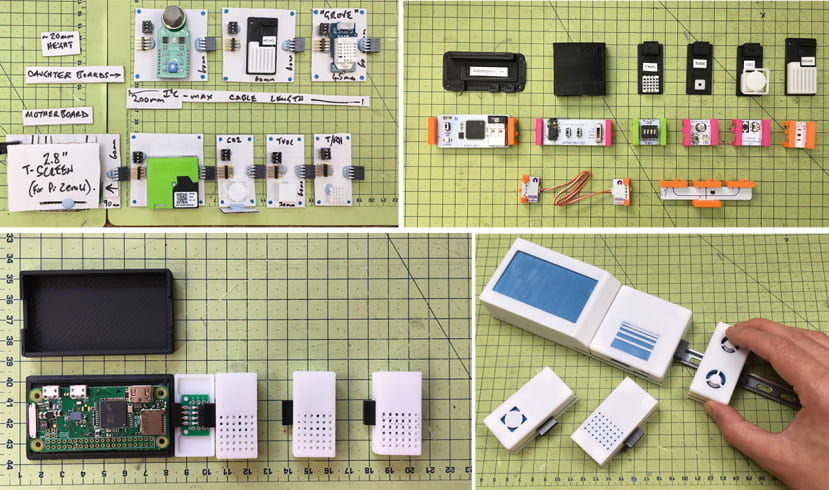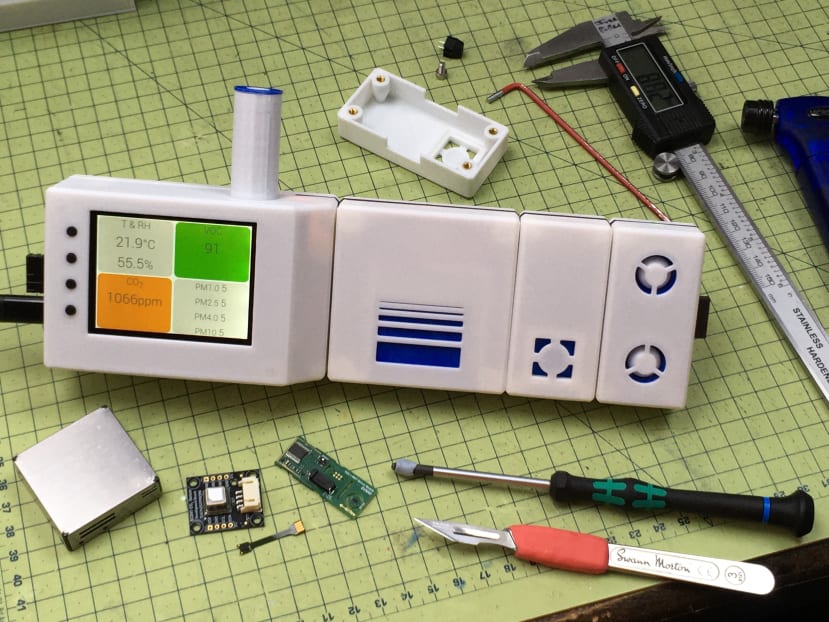The DesignSpark Air Quality Project, behind The Good Air Canary
Follow articleHow do you feel about this article? Help us to provide better content for you.
Thank you! Your feedback has been received.
There was a problem submitting your feedback, please try again later.
What do you think of this article?
CO2, Creativity and Coronavirus...And Canaries.
These past 6 months have been an Air Quality odyssey, to say the least. What started off as a response to a report from 2018 citing polluted air is responsible for 44,000 deaths per year in the UK, has grown to a broader exploration of the nuances of how we find ourselves hearing these statistics, but with little idea of how to respond to them.
Although the Good Air Canary project might seem an oddly whimsical response to a very serious problem, the fact is we live in an age where academic white papers don’t get much attention on social media, so it needs an attention-grabbing ‘hook’ to then impart some of the more technical and subtle points.
So now that I have your attention - I hope you’ll forgive the ruse of this clickbait, but like the Canary in the Coalmine story you think you know already, this project also contains a few twists and turns worthy of a closer inspection, and I hope might improve your health and wellbeing, and equip you with some relatively simple knowledge that might help others around you as well. If you want to know how a Canary might play a role in the pandemic, or even your Creative Potential at work - read on.
What You Didn’t Know About The Canary and the Coalmine?
Cage for reviving canary, with oxygen cylinder, made by Siebe Gorman & Co. Ltd, London (https://museumcrush.org/)
Like me, you probably thought you knew the story of the Canary being used as an expendable ‘gas detector’. And it’s true that many Canaries succumbed to the toxic gasses in mines, in order to prevent human deaths, as they are much more sensitive to the toxicity - allowing miners to retreat to safety. However, what charmed me in researching this project more deeply, was that Siebe Gorman & Co went the extra mile - and added a cylinder of fresh air to the vessel shown above, whereupon the door could be closed after the bird had passed out, and fresh air being flushed into the box to revive the bird from the brink of death.
Talking Yourself Stupid
There is a wonderful irony that I was working in my 2x2x2m shed on this project on Air Quality, and getting headaches from sitting in zoom calls, as one does in the new normal working from home in 2021. Yet it was only when I purchased a desktop air quality monitor that I realised usually after an hour of me being inside with the door and windows closed the reading said ‘very unhealthy’. I realised that the CO2 was reaching very high levels, but honestly assumed it was just having too many zoom calls that were mostly the issue.
Jude’s rough calculations to try and work out how bad CO2 levels are in a small home office/workshop.
Having worked in the Environmental Control Dept at Dyson, I was slightly sceptical of cheap sensors, and I realised I should sharpen my pencils - and ‘do the Math’ on just how bad the CO2 levels were in my Shed. To my surprise, there was an almost perfect correlation between my approximation of my respiration, lung capacity, and how CO2 (which is denser than Oxygen) ‘fills up’ from the floor - essentially ‘downing me’ in my own hot air after about 1-1.5 hours.
My wife didn’t miss an opportunity to make fun of me ‘talking too much, or too much of my own ‘hot air’ being bad for me - and now armed with scientific proof, I started to explore more deeply just how bad the problem really was. Since working on this for some months now, I’ve spotted other articles starting to appear more in the news, as working from home poses its own challenges to our health: One FastCo article cries that “our office air is making us stupider”, and that “our indoor air is often more polluted than our outdoor air”.
Jude’s rough calculations to try and work out how bad CO2 levels are in a small home office/workshop.
As I read more around the subject, including military, government and scientific sources - this figure of 4000ppm CO2 was linked to ‘seriously impaired ability to think laterally or strategically’, which effectively meant you would not problem solve in a high-pressure situation like work or when operating machinery.
As a Creative Technologist - ‘lateral thinking’ is the essence of what most creative people call ‘creativity’. So at 4000ppm (my room after 1 hour of yakking away) nobody is healthy, and nobody is going to make a creative breakthrough in their career. I decided to build an IoT Canary, source some cost-effective Sensors - and of course, to crack a window!
Interchangeble Sensors Galore!
A variety of Sensors from Sensirion; as well as a collection of Little Bits (A plug-n-play electronics STEM toy); Early ‘plug-n-play’ concept with a Pi Zero microcomputer for the sensors; 3D printed scale model of sensor units.
One of the things I loved about working at LEGO was the fusion of tech and play. And this project drew from that instinct to search for the best possible Sensor technology at an affordable price but combined with the easy and intuitive interaction of a STEM toy. I even learned the term ‘BATNEEC’ (Best Available Technology Not Entailing Excessive Cost) - which really was at the crux of this project: The General Public cannot afford high spec sensor kits, which can run into the thousands of pounds, but it’s fair to say these sensors at tens of pounds were not as good as a lab-grade sensor.
As mentioned in the video, I realised that the key was to observe the trend, rather than worry too much about the accuracy of the Sensors. As frankly - if you consider background CO2 levels are about 500ppm - so if my sensor reads 4000ppm - even if this were 10% inaccurate, I’m still at least 3-4x the recommended limit of 1000ppm.
The DesignSpark Environmental Sensor Development Kit (ESDK ) with Particulate, CO2, VOC, Temperature and Humidity Sensors (and GPS).
What might appear as a simple ‘plug-n-play’ adaptation from LittleBits - to upgrade with industrial sensors in fact took considerable collaboration with AB Open to perfect, and run on the ubiquitous Raspberry Pi, and make open source: The Environmental Sensor Development Kit or ‘ESDK’ is an embodiment of the BATNEEC principle - which allows people to access reasonably accurate data on pollution inside their homes, for a reasonable cost - but with much more control than buying a ‘Home Air Monitor’.
It must be said that there are parts of this project which do already exist - Dyson conducted a study on air quality around schools, but the data was not publicly available (the ESDK allows the data to be shared anonymously if you wish). Likewise, some Air Quality Monitors are more compact and cheaper, but their sensors are more compact but less accurate as a result, (the ESDK is not so compact or as easy to use, but has a higher specification of sensors than many). Our aim is not to say one is better than the other, but rather that this ‘rising tide’ of technology, awareness and knowledge - ‘lifts all boats’, and helps us all to have more agency around air quality, data and citizen science.
Starting Small (And Fun) - The Good Air Canary.
Cardboard and 3D Printed Prototypes of the Canary Automata Mechanisms and Electronics.
One of the most fascinating insights of the project was learning that CO2 sensors were selling at record highs - this was because they were being used in the fight against the pandemic: If you are a carrier of Coronavirus, when you breathe out, you not only exhale coronavirus particles in water droplets, but you also exhale CO2 at a proportional rate. So although nobody has a means to detect viral particles in mid air (the science of this is staggeringly difficult - I did ask experts - but basically they are really small, and you can’t tell the difference between Coronavirus and a Cold), the good news is that CO2 can be used as a ‘proxy’ for the risk of Coronavirus in the air. Granted that this is a worst case assumption, but for the cost of tens of dollars you can say with reasonable confidence that the air in a school, office or restaurant is stuffy, and windows should certainly be opened.
For me this is when the Canary gag came ‘full circle’ - and delivered its more serious and impactful message - it is of course a whimsical desktop gizmo that prompts you to open a window for the benefit of your creativity, but the very same technology if used in public places could provide a meaningful proxy to warn others against air being stagnant, with high CO2 concentration, and therefore statistically more likely to contain Coronavirus at high enough levels to pose a risk.
The reason it is called a Good Air Canary (rather than just limited to being a CO2 Canary) is that it can also alert you to Particles from dust and allergens in your home, VOCs from cooking, clearing products, or even passive smoking. It is something that your kids can understand, but the same data can also be parsed to the cloud (anonymously) so that others can be informed, be it general public, local councillors or scientists taking a global view of the health of our air.
Your takeaways and actions from this project could be any of the following:
Individuals
- Open your windows if you are lucky enough to live near fresh air, and don’t starve your concentration and creativity of oxygen.
- If your outdoor air is concerning you, then perhaps a cheap air quality monitor will help you pick the best times of the day to ventilate your home (mornings are usually best).
- If you have specific allergies (or have headaches a lot), gaining insight into possible triggers and irritants might help you understand and manage your symptoms.
- It could be that you are concerned about loved ones, and using the IoT (remote) function of the ESDK and Canary - you can observe in an un-intrusive way.
- If your school is by a main road, and your kids are in the playground, this is almost certainly not good. Is this ESDK ‘certified’ or ‘lab standard’, certainly not, but you can build evidence beyond unscientific opinion - that warrants further investigation. You may see times of the day which are least safe for kids to take recess for example, or perhaps you might not drive your kids to school when the weather is fine.
- Although I do not advocate smoking - if you smoke 20 a day indoors, chances are you’re probably smoking ‘extra’ by re-breathing the smoke you just exhaled. Even if you struggle to quit - you’d do yourself (and anyone else living with you) a favour by smoking outside.
- Have you ever woken up feeling sluggish in the morning...did you try opening the window a little before you went to bed? (I tried this as a result of this project - and it’s a game changer... #yourewelcome).
Advocacy Groups/Institutions
- Perhaps you are an organisation that is interested in health and/or data - in which case - get in touch, we’d love to hear more and have you try out or ESDK kits.
Engineers/Makers
- Or perhaps you’re a keen enthusiast - an ‘Activist Engineer’ as some might call it - and you have a different idea around how to engage people with Science, Tech, Data and Art. We need more ideas to help people engage with the very real problem of Air Quality. Please also get in touch. Tell us what you want to make?
The Good Air Canary - is almost completed. Stay tuned for the final version - and the DIY Guide to make one yourself!
I hope this project has give you some ideas on not only the importance of good air, your health and wellness - but also how you can get involved at any number of levels to make a difference. Please consider subscribing and following this - and 11 other amazing projects coming soon.
Credits -
The DesignSpark Environmental Sensor Development Kit (ESDK), affectionately known as the “Jam Sandwich”, has been designed and developed as open hardware and software in conjunction with Award-Winning Creative Technologist, Jude Pullen and Andrew Back and Callum Snowden of AB Open.
Created by DesignSpark in conjunction with;
Jude Pullen - Overall Concept and Key Design Features
AB Open Ltd - Hardware Design, Development, and Layout
AB Open Ltd - Software/Firmware/API/Cloud Integration
Jude Pullen - Enclosure Design
This is a callout to Engineers to take action to help us build and deploy a community-led global network of air quality monitors for your homes or workplaces. We will share with you how some earlier adopters will be using our Air Quality kits to drive change where they are located by creating some amazing applications that interact with the kits. Coming soon, we will ask the DesignSpark community to apply to be a BETA tester and receive a free kit to take part.
Lookout for more information in our weekly newsletter (you can opt in via Contact Preferences under your profile).


